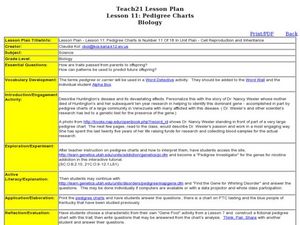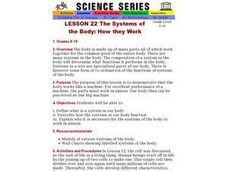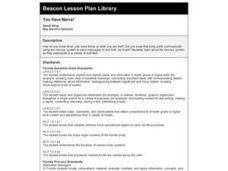Curated OER
Pedigree Charts
Students explain how offspring inherit traits from their parents. In this biology instructional activity, students investigate the genes for nicotine addiction using an interactive website. They construct a fictional pedigree using their...
Curated OER
Where Are The Dinosaurs?
Students study what happened to the dinosaurs and possible causes of extinction. In this investigative lesson students create dinosaur eggs.
Curated OER
Building a Circulation City
Students identify the different organ systems found throughout the human body. Using a model, they explain and draw the flow of blood and name the parts of the circulatory system. They create their own circulation city in which to show...
Curated OER
Mass vs. Weight
Students explore physical science by conducting a measurement experiment. In this mass lesson plan, students identify the differences between mass and weight and define a list of other vocabulary terms. Students utilize electronic scales...
Curated OER
Cytoplasmic Streaming
Students prepare successful wet mount slide of Elodea. They determine and identify environmental conditions that induce cytoplasmic streaming. They determine the positive aspects of cytoplasmic streaming. They illustrate knowledge and...
Curated OER
Teaching Biotechnology With Models
Pupils will construct models to obtain understanding about the scientific concept. The kinesthetic learners will benefit from the project. There is ample opportunity for all types of learners to be engaged in this lesson.
Curated OER
Frogs and Camouflage
Students view a variety of pictures of frogs and discuss camouflage and habitat adaptation. Students look at color, skin texture, shape, size, eyes, and surroundings as well as the need for the camouflage. Students then design a frog...
Curated OER
Aerobic vs. Anaerobic Respiration
Students define aerobic and anaerobic respiration. They compare and contrast the processes of aerobic and anaerobic respiration. Students identify organisms that use the processes of aerobic and anaerobic to synthesize energy from food.
Curated OER
Real or hoax?
Seventh graders brainstorm a list of criteria that makes a webpage useful for research and not useful for research. They complete the activity, "Real or Hoax," and discuss fiction and non fiction stories and determine which websites are...
Curated OER
Undercover in the Secret State
Learners examine the current conditions in North Korea. They view and analyze a CNN documentary, research a dissident, answer and discuss questions about the documentary on conditions in North Korea, and identify the technology used by...
Curated OER
Back to the Past
What was the Untied States like in 1938? What were the concerns of Americans in the post World War I era? What were their fears? What were their sources of news and entertainment? To understand the reaction to Orson Welles' radio...
Curated OER
The Systems of the Body: How they Work
Students study what a body system is, how they function and how the systems work in unison.
Curated OER
Body Organization and Organ Systems
Eighth graders begin the lesson by building a house of cards. They discuss ways that building a house of cards is similar to the way the body is built: different systems work together to help the whole body work together. Students listen...
Curated OER
Genetic Engineering
Students discuss the risks and benefits associated with biotechnology. For this biotechnology lesson, students discuss the role of genes in the body and brainstorm ethical issues relating to biotechnology. They read about an ethical...
Curated OER
Dogs & Darwin
Ninth graders construct and conduct a laboratory experiment illustrating the transfer of mutations. They compare and contrast natural selection in organisms with long and short reproductive cycles.
Curated OER
Genetic Disorders with Cultural Roots: International Insects
Learners recognize that certain populations have specific genetic disorders that could benefit or harm them in their environment, work out punnett square problems and infer offspring probabilities from results, and provide advantages and...
Curated OER
Liver
Pupils study the livers parts and functions then follow a lab experiment to watch first hand how the gut uses bile to physically break down fatty substances into smaller pieces.
Curated OER
The Paleozoic Era
Students access prior knowledge to create a chart of eras. For this Paleozoic era lesson, students research the Paleozoic era to find information to create dioramas. Students participate in fossil activities.
Curated OER
What a Waste!
Fourth graders explore the kidney, bladder, and function of the excretory (urinary) system.
Curated OER
Meiosiss Revisited
Seventh graders are engaged in a lesson that covers the concept of meiosis with the intention of covered sexual reproduction. They cover the concept of genetic traits and how they are transmitted over generations with or without...
Curated OER
Algal Blooms
For this algal blooms worksheet, students order the stages of a red tide. They answer two short answer questions. Students define three terms relating to algal blooms.
Curated OER
The Skeleton Within
Fourth graders explore the bones, joints, and other attributes of the skeletal system.
Curated OER
You Have Nerve!
Fourth graders investigate the nervous system and how it communicates messages to and from the brain.
Curated OER
Gene Regulation Mechanisms
Students explore the control of expression of DNA into proteins which is divided into two main categories: transcriptional and post-transcriptional. They construct examples of the control mechanisms and discuss disease processes that...

























